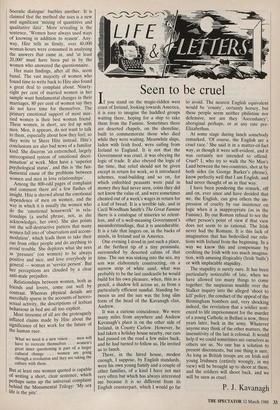The majority stays silent
Anne Chisholm
WOMEN AND LOVE: THE NEW HITE REPORT by Shere Hite Viking, .04.95 Perhaps the most cheering fact about the latest offering from Shere Hite, the American post-feminist researcher who has, over the last 12 years, surveyed female and male sexuality and has now moved on, for the final part of her 'monumental trilogy' to women and love, is that 95,500 women who were sent her questionnaire decided not to answer it. One hundred thousand questionnaires went out and a mere 4,500 came back. So, Hite-style, one could conclude that 95.5 per cent of women surveyed took no interest in con- templating their relationships, analysing their feelings and banging on about what a ghastly business it all is, and just carried on doing their jobs, living their lives, and muddling through like the rest of us, sometimes feeling happy, sometimes sad.
The ominous-sounding Shere Hite (the name, apparently not her original one, evokes something predatory out of Kip- ling) takes herself and her subject deeply seriously. On the one hand, this is not a bad thing; someone had to spend time and energy exploring the anxieties exposed by the women's movement 20-odd years ago. Hite's combination of portentousness, tenacity, and flair for publicity have kept her at it and made her rich and famous. On the other hand, it is a pity that her ideas, in the end, are as commonplace as her style.
'Hallo!' begins the questionnaire in a chirpy manner. 'Who are you?' Under seven headings (`Growing up female', 'Falling in love', 'Your current rela- tionship', 'Sexuality', etc), Hite put 127 questions to her respondents, ranging from the cloudy 'What do you want most from life?', to the impertinent 'Did you mastur- bate as a child?', to the gritty 'Do you share the money?' and 'How do you feel about getting older?' Her previous reports drew some sniping from academics about methodology; this one is buttressed there- fore by introductions and appendices stuf- fed with plaudits from different academics about Hite's credentials, seriousness, and general wonderfulness. 'A massive cry of the human heart', raves one of them about her work. 'Hite's approach is a kind of Socratic dialogue' burbles another. It is claimed that the method she uses is a new and significant 'mixing of quantitive and qualitative data'. More revealing is the sentence, 'Women have always used ways of knowing in addition to reason'. Any- way, Hite tells us firmly, over 40,000 woman-hours were consumed in analysing the answers that came in, and 'at least 20,000' must have been put in by the women who answered the questionnaire.
Her main findings, after all this, seem banal. The vast majority of women who found time to write back to Hite also found a great deal to complain about. Ninety- eight per cent of married women in her sample want fundamental changes in their marriages, 80 per cent of women say they do not have time for themselves. The primary emotional support of most mar- ried women is their best woman friend. These women, in short, are fed up with men. Men, it appears, do not want to talk to them, especially about how they feel; so they write to Shere Hite instead. Hite's conclusions are also bad news of a familiar kind. She discerns 'an entrenched, largely unrecognised system of emotional discri- mination' at work. Men have a 'superior Psychological status', and this is 'the fun- damental cause of the problems between women and men in love relationships'.
Among the 800-odd pages of complaint and comment there are a few flashes of insight. Hite is shrewd about the emotional dependence of men on women, and the way in which it is usually the women who do the 'emotional housework' in rela- tionships (a useful phrase, not, as she acknowledges, her own). She also points out the self-destructive pattern that many women fall into of 'observation and accom- modation', which leads them to take their cue from other people and do anything to avoid trouble. She deplores what she sees as 'pressure' (on women) to be always Positive and nice, and love everybody in general — woman as 'service person'. But her perceptions are clouded by a clear anti-male prejudice. Relationships between women, both as friends and lovers, come out well by contrast. Whereas physical details are mercifully sparse in the accounts of hetero- sexual activity, the descriptions of lesbian behaviour in bed are all too explicit.
Most tiresome of all are the grotesquely inflated claims made by Hite about the significance of her work for the future of the human race.
What we need is a new vision . . . men will have to recreate themselves . . . women's great inner questioning is part of a larger cultural change . . . women are going through a revolution and they are taking the culture with them.
But at least one woman quoted is capable of writing a short, clear sentence, which Perhaps sums up the universal complaint behind the Monumental Trilogy: 'My sex life is the pits'.



















































 Previous page
Previous page